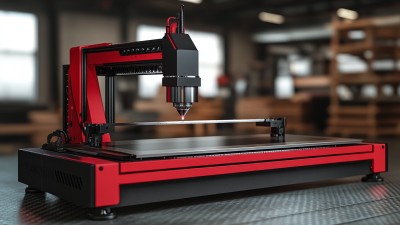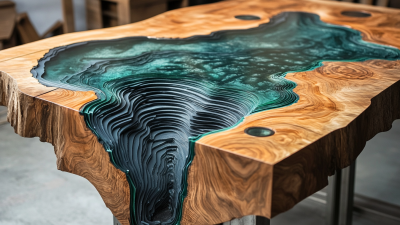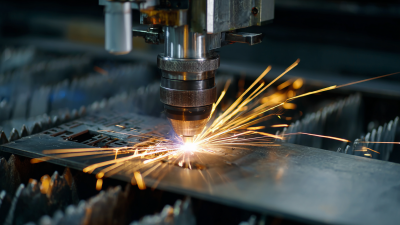How to Choose the Right Plasma Table for Your Business Needs
 Choosing the right Plasma Table for your business needs is a crucial decision that can significantly impact your productivity and efficiency. In today’s competitive market, having the right equipment tailored to your specific requirements can make all the difference. Whether you are operating in metal fabrication, sign making, or any other industry that relies on precision cutting, understanding the various features and specifications of Plasma Tables is essential. From the cutting speed and size capabilities to the software compatibility and price range, each factor plays a vital role in ensuring that the table you select aligns with your operational goals. This guide aims to equip you with the knowledge needed to navigate the complexities of Plasma Table selection, allowing you to make an informed choice that enhances your business processes and drives growth.
Choosing the right Plasma Table for your business needs is a crucial decision that can significantly impact your productivity and efficiency. In today’s competitive market, having the right equipment tailored to your specific requirements can make all the difference. Whether you are operating in metal fabrication, sign making, or any other industry that relies on precision cutting, understanding the various features and specifications of Plasma Tables is essential. From the cutting speed and size capabilities to the software compatibility and price range, each factor plays a vital role in ensuring that the table you select aligns with your operational goals. This guide aims to equip you with the knowledge needed to navigate the complexities of Plasma Table selection, allowing you to make an informed choice that enhances your business processes and drives growth.
Key Factors to Consider When Selecting a Plasma Table for Your Operations
When selecting the right plasma table for your business operations, several key factors come into play. First and foremost, consider the size and capacity of the table. You need to assess the maximum dimensions of the material you’ll be working with, as well as the thickness of the materials your plasma cutter can handle. A larger table may offer the flexibility to accommodate diverse projects, but it should also align with your workspace and operational workflow.
Another important factor is the type of plasma cutting system compatible with the table. Ensure that the plasma table you choose can effectively integrate with your existing equipment or that it comes with its own reliable cutting system. Additionally, pay attention to the software capabilities of the plasma table. Advanced software that provides features such as nesting and programming can significantly enhance productivity and precision, making your cutting operations more efficient. Evaluating these aspects will help you select a plasma table that meets your specific operational needs while driving your business towards success.
Understanding Different Types of Plasma Tables and Their Applications
When selecting a plasma table for your business needs, it is crucial to understand the different types available and their specific applications. Plasma tables generally fall into two main categories: entry-level and industrial-grade models.
Entry-level tables are designed for smaller operations, where budget constraints and minimal production demands are key factors. These tables are often portable and user-friendly, making them ideal for hobbyists or small fabrication shops. However, they may have limitations in terms of cutting thickness and speed.
On the other hand, industrial-grade plasma tables are built for high-volume production and can handle a wider range of materials and thicknesses. They are equipped with advanced features such as automated height control and integrated software systems that enhance cutting precision and efficiency. These tables are suitable for larger businesses that require consistent, high-quality output and are capable of managing complex designs. Understanding the specific requirements of your business will help determine which type of plasma table fits your operational needs best, ensuring that you invest in the right equipment to maximize productivity.
Evaluating Your Budget: Finding the Best Value for Your Plasma Table
When considering the purchase of a plasma table, evaluating your budget is a crucial step in ensuring you find the best value for your business needs. Start by determining how much you can realistically allocate for this investment. Plasma tables vary widely in price, influenced by factors such as size, features, and brand reputation. Setting a clear budget helps streamline your options and allows you to narrow down your choices without overspending.
Once you have a budget in mind, assess the long-term benefits and efficiency of the different plasma tables available. Think about the features that are essential for your operations, such as cutting speed, software capabilities, and material compatibility. Investing a bit more in a high-quality plasma table may pay off in greater productivity and fewer maintenance issues over time. Conducting thorough research and comparing models within your budget ensures you maximize your investment while meeting your specific business needs effectively.

How to Assess Size and Space Requirements for Your Business Setup
When selecting the right plasma table for your business, understanding your size and space requirements is crucial. According to the Fabricators & Manufacturers Association (FMA), approximately 70% of businesses underestimate the space needed for equipment, which can lead to operational inefficiencies. To avoid this pitfall, measure your intended workspace and consider your workflow to ensure that the plasma table fits comfortably within your environment while allowing for easy movement and accessibility.

Additionally, it's essential to factor in the dimensions of the materials you'll be working with. The North American Manufacturing Association suggests that most industrial plasma tables range from 4x8 feet to 10x20 feet. However, businesses engaged in larger scale operations may require specialized larger formats. Assessing your production volume and the types of projects you'll undertake will help determine whether a standard size will suffice or if you'll need a more extensive setup. Properly evaluating these space requirements will not only enhance efficiency but also optimize safety, reducing the risk of accidents in a cramped work area.
Integrating Technology: Features to Look for in Modern Plasma Tables
When selecting a plasma table for your business, it’s crucial to consider the technological features that enhance productivity and precision. Look for models equipped with advanced CNC (Computer Numerical Control) systems. These systems allow for greater control over cutting paths, ensuring that intricate designs can be executed accurately. Additionally, a table with robust software compatibility enables seamless integration with design applications, streamlining the workflow from design to production.
Another vital feature to consider is the table’s capacity for material handling. A modern plasma table should support a variety of materials and thicknesses, accommodating the diverse needs of different projects. Features like automatic height control and fast cut speeds can significantly improve efficiency, allowing you to maximize output while maintaining high-quality results. Furthermore, safety features, such as fume extraction systems and protective enclosures, are essential for sustaining a safe working environment, ensuring that your operations can run smoothly and without interruption.
How to Choose the Right Plasma Table for Your Business Needs
| Feature | Importance | Recommended Specifications | Common Applications |
|---|---|---|---|
| Cutting Speed | High | 100-200 IPM (Inches Per Minute) | Metal Fabrication, Automotive |
| Plasma Power Source | High | 45-85 Amps | Construction, Manufacturing |
| Table Size | Medium | 5'x10' Standard | HVAC, Sign Making |
| Software Compatibility | High | AutoCAD, SolidWorks | Aerospace, Prototype Development |
| Material Versatility | Medium | Mild Steel, Stainless Steel, Aluminum | Art, Furniture |
Related Posts
-

Challenges When Choosing the Right Best Cnc Plasma Table for Your Business Needs
-

10 Ways Cnc Plasma Cutting Tables Transform Your Manufacturing Efficiency
-

7 Must-Know Strategies for Sourcing the Best Plasma Cutting Tables Globally
-

Discover Innovations in Plasma Cutting Technology at the Record-Breaking 137th Canton Fair
-

How to Choose the Best Cnc Plasma Cutting Machine for Your Business Needs
-

Ultimate Guide to Maximizing Efficiency with CNC Plasma Cutting Machines